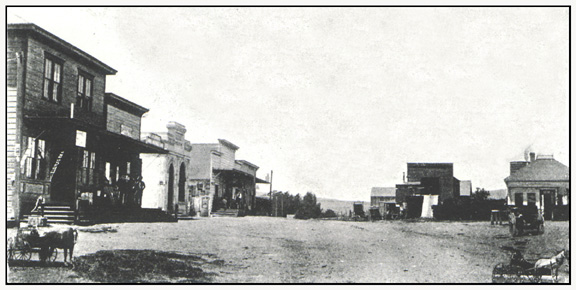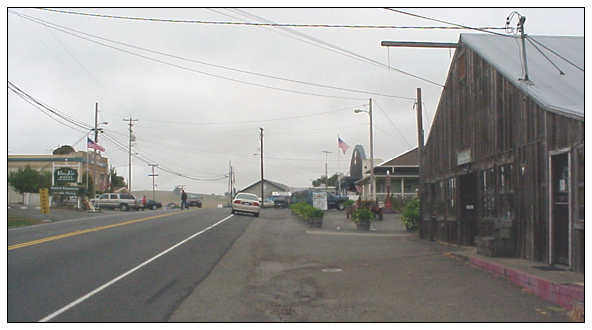

|
From a Historical and Descriptive Sketch of Sonoma County, California, by Robert A. Thompson (Philadelphia: L. H. Everts & Co., 1877), pp. 101-103: |
||
|
VALLEY FORD The town of Valley Ford is situated on the Estero Americano, four miles from its mouth. Here the old Spanish and Indian trail leading from the interior ranchos to Tomales bay and the coast, crossed the Estero, hence the name which was given to the farm adjoining, and subsequently to the town. At this point the trail forked, and the one which led up the valley was the route traveled from Bodega rancho to Saucelito. It was the custom among the Indians in the back country to take two or three journeys each year to the coast for the purpose of feasting on shell-fish, and gathering shells for the manufacture of Indian money. Tomales bay and the coast to the east of the Estero, was the most frequented sea-side resort of the Indians. The trail which crossed the Estero where Valley Ford stands, was on the main route. After 1857 they ceased their annual pilgrimages. Often previous to that time their bands might be seen filing along the way, embracing all sorts and conditions of Digger Indian life, from "El Capitan," who usually rode a lean, half-tamed mustang, to the old crones with high baskets hung to their backs by a band across their foreheads, loaded with a promiscuous assortment of rags, old blankets, attole, pinole, papooses, cooking utensils, etc. The fording of the Estero was their usual halting place. S. L. Fowler and J. E. Fowler arrived in San Francisco in May, 1849. After many hardships, chance brought them to Big Valley, better known as the valley of the Estero Americano, then an unfenced wilderness. Not a furrow had been plowed, and a wealth of grass clothed the hills. They settled where the trail crossed the Estero, and purchased of F. G. Blume six hundred and forty acres of land lying between the Ebabias creek and the Estero. In July following they built a house two hundred yards from the ford. Thomas Smith, who had been engaged running a saw-mill with Messrs. Hendy & Duncan, near where John Vanderleith now lives, built a cabin on the point between Ebabias creek and the Estero, which tract they had purchased of F. G. Blume, and with his partner, R. Gahen, prepared to put in a crop of potatoes. Sanford & Stone located across the creek on the place now owned by Roach & Webber. They received a portable grist-mill from the east, and in the winter of 1852 and 1853 they ground the grain raised in the neighborhood. The mill was small and the flour coarse and unbolted, but they were kept busy by the settlers, who waited their turn at the mill. Whitehead Fowler came to the country in 1852. The same year E. Thurber settled upon the tract east of town, now owned by A. P. Garver. These were the first settlers at Valley Ford and the adjoining ranches. In May, 1854, Stephen C. Fowler and his wife, the parents of S. L., James E., and W. Fowler, with their three sons, John H., Benjamin, and Nathaniel, arrived at Valley Ford. Mrs. Fowler was the first female resident of the town, and both she and her husband have resided continuously in the latter place from that day to this, having now attained the ripe age of eighty years -- recently celebrating the fifty-fifth anniversary of their marriage in their residence on the Estero. What had been formerly but an Indian trail had now become a well traveled road. Several other persons took up claims, among them were some having families, but by far the greater number "bached it." A crop of oats yielding one hundred bushels to the acre was raised in the summer of 1854 upon what is now the town site. In 1856 Thomas Smith ran his grist-mill with twelve horses and two runs of stone. Two years later a steam engine took the place of horses, and the mill soon became famous for the excellent quality of flour made there. In the fall of 1861 Daniel Hall opened a blacksmith shop. In the spring of 1861 John H. Fowler opened a general merchandise business. A bridge was built across the creek about the same time. James E. Fowler opened a lumber-yard, and E. B. & J. W. Palmer built a carpenter shop. In 1863 the Methodist church was built. J. N. Rien built the Valley Ford hotel in 1864. An express and post-office was established. There is a lodge of Good Templers and a Templer hall. A Methodist society, and a Presbyterian society, with a Sunday-school. A district-school is kept in the village. In the summer of 1876 the North Pacific Coast Railroad Company extended their road through the town, and built a neat depot. The people can now reach San Francisco in about four hours' time. Previous to the building of this road the people received their goods and hauled their produce to and from Petaluma, a distance of eighteen miles, and traveled the same route to San Francisco; hence they welcomed the railroad which brought an end to those tedious journeys. In 1876 P. E. Merritt opened a new grocery store in the place. J. Parry opened a tin shop, and John Hunter opened a meat market. With her railroad facilities, fine climate, and rich and productive surrounding country, why should not Valley Ford continue to grow and prosper?
|
|
From the Illustrated Atlas of Sonoma County California: Compiled and Published from Personal Examinations, Official Records and Actual Surveys, (Published by Reynolds & Proctor, Santa Rosa, Cal.: 1897), p. 50: |
||
|
Valley Ford is a postoffice village situated on the Estero Americano, four miles from its mouth, in Bodega township, 18 miles southwest of the county seat, on the line of the N. P. C. R. R., and 61 miles from San Francisco. The trail first made by the Digger Indians from Tomales to the coast and the northern ranches, crossed the estero at this point hence its name. The first house was built here by S. L. and J. E. Fowler in 1849, who puchased six hundred and forty acres from F. G. Blume. The enterprise of grist grinding was commenced in 1853-4, by Sandford and Webber with a portable mill, and they were kept busy grinding unbolted meal from wheat brought in by the farmers. In 1856 Thomas Smith, who had been at one time sawing lumber with Alexander Duncan, and who had for two or three years been engaged in potato growing in the vicinity, set up a grist mill with two pair of stones run by twelve horses. Two years later he added a steam engine, and as years passed on Valley Ford mill became famous for the good quality of it flour. The mill still exists but this section has gone out of grain raising, it has been tranformed into a butter factory. In 1854, Stephen C. Fowler and his wife, the parents of S. L., James E. and W., with three other sons, John H., Benjamin and Nathaniel, arrived at Valley Ford and took up their residence there. Mrs. Fowler was the first lady resident in the town, and with her husband and her sons around her, lived there beloved and respected by all, to be an octogenarian. John H. Fowler was the first to start the general grocery business, and James E. Fowler a lumber yard. This was in 1861. Daniel Hall established a blacksmith shop and E. B. and J. R. Palmer a carpenter shop. J. N. Rien erected and conducted the first hotel. Express and post offices followed, with churches, schools and beneficiary lodges, until now there are two stores of general merchandise, bank, two hotels, one carriage and blacksmith shop, one blacksmith, undertaker, shoemaker, barber shop, physician and a number of saloons. There are several neat residences, a public school of two departments, and two churches.
|

Valley Ford June 2002
![]()
This page created on 04/08/01 14:02. Updated 05/10/15 17:31.